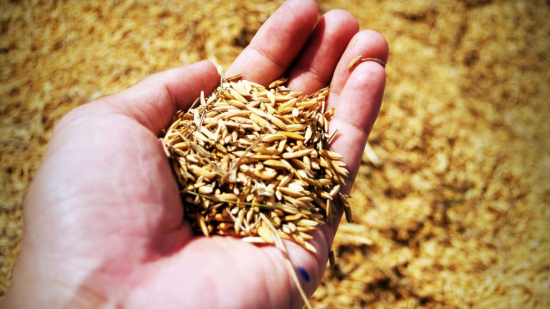The Institute of Agrochemistry and Food Technology demonstrates that rice bran can become a sustainable and cost-effective source for producing industrial enzymes. Fermentation with fungi transforms this by-product into enzyme cocktails that can be used to produce biofuels, lactose-free products or bio-pesticides, among other applications
Rice is the second most produced crop in the world, generating more than 72 million tons of rice bran annually. This bran, the outer layer removed during the polishing process of white rice for human consumption, is an agricultural by-product that is commonly used in low value added applications such as animal feed. However, a research team from the Institute of Agrochemistry and Food Technology (IATA), located in the scientific-academic area of the Science Park of the University of Valencia (PCUV) and joint centre of the Higher Council for Scientific Research (CSIC) and the University of Valencia, has found that this waste, abundant and little valued, can become a sustainable and economical source for the production of industrial enzymes with applications in the food or pharmaceutical industry through the use of filamentous fungi, commonly known as molds.
Because of its nutritional profile (50% carbohydrates, 15% protein and 20% fat), rice bran is an optimal substrate for the development of these moulds. Its growth, under controlled conditions, allows the production of enzymes with a wide range of industrial applications. Filamentous fungi produce and release proteins called enzymes as part of their natural feeding strategy. These enzymes accelerate chemical reactions and break down complex materials into simpler compounds that they can then use.
This process, which occurs spontaneously in nature, can be harnessed through biotechnology to transform organic waste into valuable sources of industrial enzymes. "Growing these mushrooms on agricultural by-products produces enzymatic cocktails that have multiple applications in sectors such as food, pharmaceuticals or energy, turning what was once a waste into a resource with high added value.", explains Sandra Garrigues, a researcher from the IATA-CSIC Fungal Biofactories group that is participating in the study.
"Growing these mushrooms on agricultural by-products produces enzymatic cocktails that have multiple applications in sectors such as food, pharmaceuticals or energy, turning what was once a waste into a resource with high added value", Sandra Garrigues, IATA researcher
The team succeeded in isolating 16 strains of filamentous fungi present in rice bran, belonging to well-known genera such as Aspergillus, Penicillium and Mucor. These strains were evaluated for their ability to produce enzymatic cocktails capable of degrading plant components such as cellulose and xylene, two plant polysaccharides essential in the structure of plants, and predominant in rice bran, in addition to producing antifungal proteins, thus expanding its potential for applications in plant health or biomedicine.
Enzyme biofactories with industrial applications
Fungi function as small organic factories or bio-factories, producing enzymes of great strategic interest. Enzymes produced by molds in this study can be applied to the production of biofuels (cellulase and β-glucosidase); to the bakery industry (xylanase and β-xylosidase); for juice clarification and animal feed improvement (α-L-arabinofuranosidase); and to obtain dairy products for lactose intolerant people by breaking down this substance (β-galactosidase or lactase).
"Each enzyme is designed for a specific task, as if it were a key that only fits into one particular lock. Thanks to them, processes that would take a long time in nature happen in seconds. For this reason they are of great industrial interest, since they allow many processes, from food manufacturing to the production of detergents or biofuels, to be more efficient and fast and less polluting", says Paloma Manzanares, Member of the IATA-CSIC research group.
The study also identified proteins with antifungal potential produced by fungi of the genus Penicillium. Specifically P. parvofructum generated up to three types of these small proteins, rich in cysteine, which have the ability to inhibit pathogenic fungi without affecting human cells. "Antifungal proteins have great potential in the field of bioplacicides or as antimicrobial agents in agriculture and medicine," adds Jose F. Marcos, researcher from the group that publishes the study.
"Each enzyme is designed for a specific task, as if it were a key that only fits into one particular lock. Thanks to them, processes that would take a long time in nature happen in seconds. For this reason they are of great industrial interest, since they allow many processes, from food manufacturing to the production of detergents or biofuels, to be more efficient and fast and less polluting", Paloma Manzanares, IATA researcher
Towards more sustainable enzyme production
Today, the industrial production of enzymes depends on costly chemical or bacterial processes. This paper proposes a more sustainable and low-cost alternative based on the fermentation of fungi on agricultural waste. "While more research is still needed to optimize performance, scale processes and comply with regulatory regulations, the results reinforce the role of fungi as key biotechnological tools in the transition to a circular bioeconomy.", concludes the research group.
This work has been made possible thanks to the funding of the BioValRice project of the AGROALNEXT call, with the support of the Recovery, Transformation and Resilience Plan of the European Union and the Generalitat Valenciana, and has been published in the scientific journal Journal of Fungi. In this project, the research group is working on obtaining bioactive compounds from waste from the rice industry, with the aim of applying them to the bio conservation of bakery products, extending their shelf life, improving their safety and preserving their organoleptic characteristics.
Source: IATA
Yélamos, A. M., Marcos, J. F., Manzanares, P., & Garrigues, S. (2025). Harnessing Filamentous Fungi for Enzyme Cocktail Production Through Rice Bran Bioprocessing. Journal of Fungi, 11(106). https://doi.org/10.3390/jof11020106
--
Recent Posts


